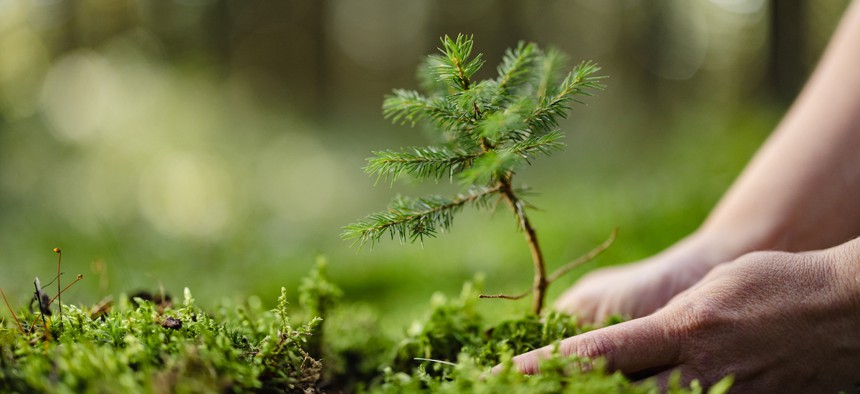Tree nurseries sprout up as a climate mitigation strategy

SimonSkafar/Getty Images
New Mexico’s Climate Ready Trees Program helps officials identify which tree types are most likely to survive in future climate conditions.
Last month was the hottest September on record, making 2023 the warmest year in history thus far, according to the National Oceanic and Atmospheric Administration. As the nation looks for heat mitigation strategies, federal, state and local governments have increasingly turned to expanding tree coverage because of its cooling effects.
While extreme heat is widely considered a major threat to public health, trees can provide lifesaving shade for residents in heat-prone communities. They can also reduce air temperatures by two to nine degrees through evapotranspiration, or the process by which plants release groundwater into the atmosphere as vapor.
But as tree planting efforts get underway with support from historic funding opportunities like the urban and community forestry grants, forestry managers are working to ensure trees are resilient to the same climate risks they’re meant to protect community residents against, said Alyssa O’Brien, urban and community forestry program manager at New Mexico’s Energy, Minerals and Natural Resources Department, or EMNRD.
In the desert southwest, New Mexico makes for “a tough environment for trees,” she said, and cities can be “anywhere from two to ten degrees warmer than surrounding land.”
The impacts of climate change—historic wildfires, drought and extreme temperatures—are also taking a toll on the state’s agriculture and farming sectors, she said. For instance, as the state tree, the pinyon pine is a staple to New Mexico’s culture and local economies, as many pickers harvest and sell pine nuts that go for around $20 a pound. But unrelenting heat could wipe out pinyon pines in decades because they won’t be able to survive New Mexico’s future climate, O’Brien said.
In a bid to build tree resilience, EMNRD recently launched the Climate Ready Trees Program in partnership with The Nature Conservancy. The program aims to help officials identify which tree types will most likely withstand New Mexico’s changing climate so they can be incorporated into future urban landscapes.
“If we’re going to live here in these cities, then we need the trees to be able to survive,” O’Brien said.
Under the initiative, EMNRD’s Forestry Division will grow tree seedlings at the New Mexico Reforestation Center, which public entities like schools or libraries can adopt. Participants are required to maintain the trees on their properties in demonstration gardens and submit an annual tree performance survey to the Forestry Division so officials can track the tree growth process, she said. Such gardens will show how trees perform under local and regional conditions and help inform sustainable urban planning decisions.
The program used climate modeling to determine current and future climate conditions based on the U.S. Department of Agriculture’s plant hardiness zones, which are determined by average minimum winter temperatures in an area, O’Brien said. Those temperature standards help planters decide which vegetation types are most likely to thrive in a region. Plus, a statewide map shows what zones New Mexico cities are in now and will be in 50 years so that program managers and participants can more effectively decide which trees to plant in coming years.
The city of Alamogordo, for instance, is currently in Zone 8a, meaning minimum temperatures range from 10 to 15 degrees, but will shift to Zone 9b, with low temperatures ranging from 25 to 30 degrees. Researchers found the most climate-adaptable trees grow in the 9b zone, which is optimal for trees like the Chinese pistache, the white oak and the honey mesquite.
The cost to implement the program ranges from $5,000 to $15,000 a year, depending on factors like seed type and availability or the amount of time a tree needs to grow before being adopted, O’Brien said. This year, 900 seedlings, which have been growing for three years, are available for the first round of adoptions. In 2024, EMNRD will have up to 3,000 year-old trees to give away.
The program receives funding from the federal Urban Tree Improvement Program and State Urban Forest Resilience Grant as well as New Mexico’s Urban and Community Forestry Program.
Tree adoption programs exist in many cities and states. In Riverside, California, community members can purchase up to five trees a year to receive a $40 rebate per tree. In Maryland, Baltimore’s Growing Home program offers homeowners $10 to plant a tree in their yard to enhance trees’ benefits for communities.






